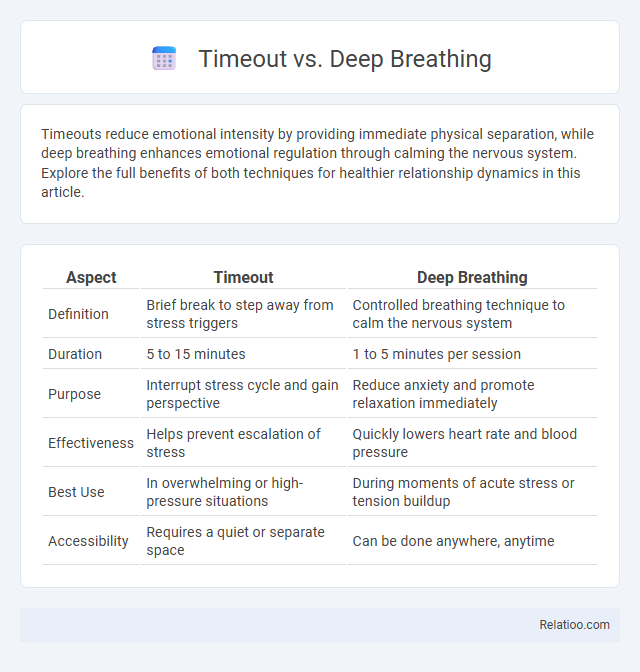Timeouts reduce emotional intensity by providing immediate physical separation, while deep breathing enhances emotional regulation through calming the nervous system. Explore the full benefits of both techniques for healthier relationship dynamics in this article.
Table of Comparison
| Aspect | Timeout | Deep Breathing |
|---|---|---|
| Definition | Brief break to step away from stress triggers | Controlled breathing technique to calm the nervous system |
| Duration | 5 to 15 minutes | 1 to 5 minutes per session |
| Purpose | Interrupt stress cycle and gain perspective | Reduce anxiety and promote relaxation immediately |
| Effectiveness | Helps prevent escalation of stress | Quickly lowers heart rate and blood pressure |
| Best Use | In overwhelming or high-pressure situations | During moments of acute stress or tension buildup |
| Accessibility | Requires a quiet or separate space | Can be done anywhere, anytime |
Understanding Timeout and Deep Breathing Techniques
Timeout involves temporarily removing oneself from a stressful situation to regain composure, effectively reducing emotional reactivity. Deep breathing techniques promote relaxation by activating the parasympathetic nervous system, lowering heart rate and cortisol levels. Combining both strategies enhances emotional regulation and stress management by allowing physical calmness through breath control alongside mental pause and reflection.
Key Differences Between Timeout and Deep Breathing
Timeout involves temporarily removing oneself from a stressful situation to reduce arousal and prevent impulsive reactions, often used as a behavioral management tool. Deep breathing activates the parasympathetic nervous system by slowing the breath, promoting relaxation and immediate physiological calm without leaving the environment. Unlike timeouts, which require physical withdrawal, deep breathing can be practiced anywhere to modulate stress responses and enhance emotional regulation on the spot.
Psychological Benefits of Deep Breathing
Deep breathing techniques enhance your mental clarity by reducing stress hormones like cortisol and promoting relaxation through increased parasympathetic nervous system activation. Unlike timeout methods that focus on behavioral pause or withholding activities, deep breathing directly improves emotional regulation and decreases anxiety symptoms. This practice supports better focus, resilience, and overall well-being, offering a powerful psychological benefit beyond simple behavioral management.
Emotional Regulation Through Timeout
Emotional regulation through timeout involves creating a deliberate pause to manage intense feelings, allowing the brain to shift from reactive to reflective states. Deep breathing techniques enhance this process by activating the parasympathetic nervous system, reducing physiological arousal and promoting calmness during the timeout period. Integrating timeout with deep breathing maximizes emotional control by combining behavioral interruption with physiological relaxation.
Applications of Timeout in Daily Life
Timeout is a practical technique used to manage stress and behavioral issues by providing a brief break from challenging situations, allowing Your mind to reset and gain clarity. In daily life, timeout can be applied during moments of frustration at work, conflicts in relationships, or overwhelming tasks to prevent escalation and promote calm decision-making. This strategy contrasts with deep breathing exercises, which focus on physiological relaxation, while timeout emphasizes mental space and emotional regulation.
Using Deep Breathing to Manage Stress
Deep breathing techniques activate the parasympathetic nervous system, effectively reducing stress hormones like cortisol and lowering heart rate to promote relaxation. Unlike traditional timeouts that physically remove an individual from a stressor, deep breathing provides an immediate tool to regain emotional control and mental clarity. Practicing deep breathing consistently enhances resilience against stress, improves focus, and supports overall emotional regulation during challenging situations.
Timeout vs Deep Breathing: Which Is More Effective?
Timeout and deep breathing are both effective strategies for managing stress and emotional regulation, but their effectiveness depends on the context and individual needs. Timeout allows You to step away from a stressful situation, creating physical and mental space to cool down, whereas deep breathing directly activates the parasympathetic nervous system to reduce tension and promote calmness in the moment. Combining these techniques often yields the best results, but for immediate anxiety relief, deep breathing tends to be more accessible and effective.
Integrating Timeout and Deep Breathing for Better Results
Integrating timeout and deep breathing techniques enhances stress management by allowing Your mind and body to reset more effectively than using either method alone. Deep breathing calms the nervous system, reducing immediate physiological arousal, while timeout provides a structured pause to reflect and regain control over emotions. Combining these methods optimizes emotional regulation and improves overall decision-making during challenging situations.
Common Mistakes to Avoid with Timeout and Deep Breathing
Common mistakes to avoid with timeout include using it as a punishment rather than a calm-down strategy, which can lead to resistance and increased frustration. In deep breathing practices, errors often involve shallow breaths or inconsistent timing, reducing its calming effectiveness. Ensuring timeouts are brief and consistent, and deep breathing is practiced slowly with full inhalations and exhalations, maximizes emotional regulation benefits.
Choosing the Right Technique for Your Needs
Choosing the right technique between timeout and deep breathing depends on your specific emotional regulation needs and context. Timeout is effective for immediate behavior control, helping to create physical or mental distance from a triggering situation, while deep breathing promotes calming and stress reduction by activating the parasympathetic nervous system. Evaluating whether you need quick behavioral management or sustained relaxation will guide you in selecting the most suitable approach for managing stress or emotional responses.

Infographic: Timeout vs Deep Breathing
 relatioo.com
relatioo.com